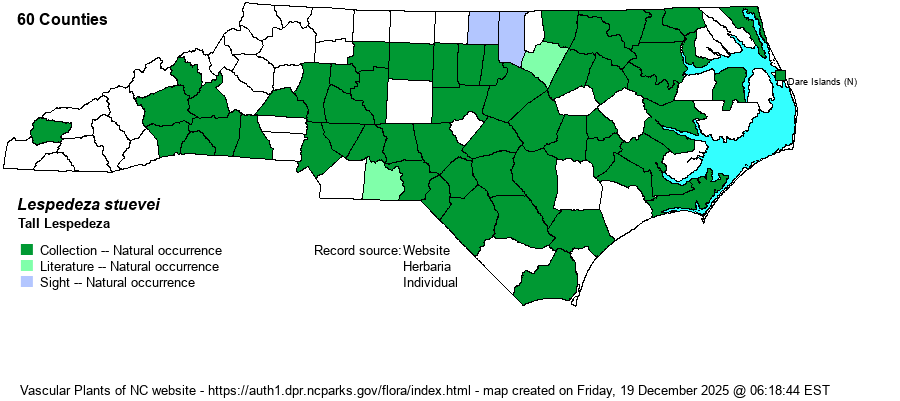| Author | Nuttall | |
| Distribution | Present over essentially all of the Piedmont and Coastal Plain, but found in the Mountains so far only in the central and southern counties. Perhaps also absent in the far northwestern Piedmont.
This is a primarily Southern and South-central species, ranging north up the Atlantic to MA and NY, and south to central FL and central TX; then in the central states only north to KY and KS.
| |
| Abundance | Fairly common in most of the Piedmont and Coastal Plain, but rare in the northwestern portions of the Piedmont; uncommon in the central and southern Mountains. Not numerous in the eastern Coastal Plain. Not as common in the state as other "statewide" species such as L. hirta, L. virginica, and L. violacea. | |
| Habitat | This is a species of typical habitats for most members of the genus -- dry woodland borders, powerline clearings, brushy thickets, openings in upland woods, and other dry and reasonably sunny ground. | |
| Phenology | Blooms from July to September, and fruits from August to November. | |
| Identification | This is a rather standard Lespedeza with few distinctive features. It has a wand-like stem reaching close to 3 feet tall, with no or few branches, if any they being ascending and near the summit. Not only is the stem quite pubescent, but so are the leaflets on both surfaces and on the petioles. The numerous leaves, consisting of the usual 3 leaflets, have a short petiole (about 1/2-inch or less); each leaflet is elliptical and medium-sized, being about 1 inch long and half as wide with a rounded apex. The flowers are in axils of the upper leaves, but are in small clusters with little stalk, such that the end of a branch or top of the stem seems to be nothing but small flowers that are each about 1/3-inch long and mainly pink-purple. This species has smaller and less rotund leaflets than does L. hirta, and its flowers are close to the stem or branch, whereas L. hirta has flowers in tight clusters on long stems well away from the axis of the main stem. L. violacea has medium-sized elliptical leaflets, but it has a distinctly "long" petiole that can be up to 1 inch long, the leaflets tend to be more rotund and less narrowly elliptical, and the leaflets and petiole are mainly glabrous. L. virginica is equally hairy overall, and also wand-like, but its leaves are very narrowly elliptical to linear, much narrower than wide and rather parallel-sided. Though hardly a scarce species in the state, it may take a bit of walking along woodland edges or in powerline clearings to encounter your first L. stuevei, and normally you will encounter one to several other lespedeza species before you encounter it. And, once you do encounter it, normally it is identified by "process of elimination", as it has so few distinct characters. | |
| Taxonomic Comments | None
| |
| Other Common Name(s) | Velvety Lespedeza, Tall Bush-clover | |
| State Rank | S4 [S4S5] | |
| Global Rank | G4? [G5] | |
| State Status | | |
| US Status | | |
| USACE-agcp | | |
| USACE-emp | | |

